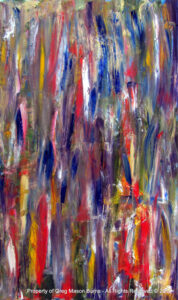
The Myth of the Right-Left Brain Mentality: City VII – Roses – Oil on Canvas (2014)
 The BATHE – Oil on Canvas (2014)
The BATHE – Oil on Canvas (2014)
Learn to be Creative
First of all I believe that anyone can be right-brained or left-brained. Overly analytical people can train themselves to be more emotional and the same goes for emotional people. The only reason why we’re analytical or emotional isn’t because that’s just the way we are; it’s because we’ve learned to accept that’s the way we are. Many of us, as I was, are unhappy leading overly analytical lives. I was a financial analyst at a children’s hospital in Boston, and I was good at it, too. But I longed for something more. Some may say that my feelings told me that I was more right-brained, and there may be some truth to that because I eventually quit my job, moved to South America, and became a painter.
 The Response – Oil on Canvas (2014)
The Response – Oil on Canvas (2014)
Science Disproves the Myth
I also don’t believe in the right-brain vs. left-brain myth is because science has actually disproven this. Are certain parts of the brain more analytical than others? Yes, but that doesn’t mean that the right side stops working, nor does it mean the right side does less than the left. They’re actually about equal. What does exist is lateralization, which is a certain section of the brain becoming more active during certain activities. Here is a great article that explains this well. Speech, for example, is predominantly done by the left brain for right-handed people, and a person’s ability to pay attention comes from the frontal lobes. But according to this article by Science-Based Medicine, while there may be some brains and some periods of people’s cognitive energy using a particular area of the brain at any given time, on average the brain uses both sides equally.
It’s How We Develop
In fact, this Johns Hopkins article suggests that all of this is cultural and comes from teachers who think they know what they’re talking about when they see an exceptionally strong student doing exceptionally strong tasks in a certain field. This isn’t a right-brain vs. left-brain activity that they’re doing. It’s based more on how they’ve developed. Furthermore, this idea actually may restrict us (I know this to be true on a personal level).
The Myth of the Right-Left Brain Mentality
So what’s my point? Do what you want. Stop being led by whatever people tell you you are. Do personality tests work? Maybe for some things. I am introverted and I know those personality tests out of the park every time, but I also hit the right-brain tests hard, too. I used to be a financial analyst. I hated it. Now I’m an artist and I love it, even the hard parts. So stop. Just do…whatever you want to do.
